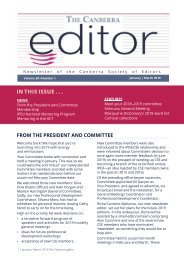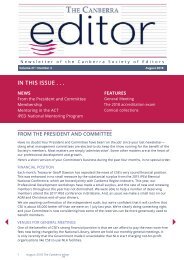ACTive Voice issue 3 2021
Create successful ePaper yourself
Turn your PDF publications into a flip-book with our unique Google optimized e-Paper software.
Jocelyn showed us the way in which the paratext – book structure, references etc – guides us and help us make
sense of a book or other work. Jocelyn discussed how situating a work in context through citing and attribution
show how an author stands in relation to the work of others and where their originality lies. For Jocelyn, this is
like setting a book in tradition. Jocelyn also referred to peritext, the elements within the work, and epitext, or the
supporting elements outside the work, eg interviews conducted as part of research, the original material that
quotes come from, the material referred to in summarising tables, etc. The contents page sets up the journey the
reader will take through the document and allows the reader to be selective.
For Jocelyn, references represent the journey beyond the book. It was interesting to be led through detailed
examples and various reference styles. Jocelyn discussed styles from a functional perspective. She spoke about
the various referencing and citations software options, specifically Mendeley, Zofero and EndNote.
Jocelyn referred members to this Wikipedia comparison of referencing software:
https://en.wikipedia.org/wiki/Comparison_of_reference_management_software.
Elizabeth Ganter
Grammar Gremlin No 6 – Full stops
In ‘Grammar Gremlins’ we look at parts of grammar that writers often get wrong, or that we editors aren’t sure
how to explain to writers who make the errors.
There is plenty of advice available on when to use a full stop. I’m going to pick out just a few of the uses that
cause headaches for editors. Remember that all punctuation is to make meaning clear. And it should follow
your style guide consistently.
At the end of a sentence: 1 space after the full stop (and that applies to question marks and exclamation marks
too – note that they both include full stops). If you put 2 spaces here, and then decide on full justification for
the paragraph, the 2 spaces after any full stop will be dragged out to make an even bigger space, so that the
line ends on the right hand margin. It’s not natural and makes reading difficult. Stick to 1 space after all full
stops at the end of sentences.
At the end of a bullet list: Use a full stop after the last list point when the individual points following an
introduction are fragments that don’t make a complete sentence until the last point. If each list point is itself a
complete sentence, put a full stop at the end of each.
In expressing time: Use a full stop (not a colon) between the hour and the minutes: 9.30 am.
Ditch the unnecessary full stops you often see in people’s initials, various short forms and symbols:
• E M Murphy (some guides recommend EM Murphy, but I like a space after each initial because each
one represents a separate given name)
• Sat 25 Dec 2021 at 1.30 pm
• CSE, IPEd, Qantas
• 10% interest, 1 kg plain flour, 30°C with strong winds.
At the end of a polite request, where a question mark would be inappropriate: Would you mind closing the
door quietly, please.
Learn more about using the full stop in Working words (revised edn) by Elizabeth Manning Murphy, Lacuna
Publishing, Sydney, 2019 – Chats 43–45 pages 163–174 and in Effective writing (2 nd edn) by Elizabeth Manning
Murphy with Hilary Cadman, Lacuna Publishing, Sydney 2014 – Section 7.2 page 65.
© Elizabeth Manning Murphy DE
page 5 of 10 ACTive Voice July August September 2021
















